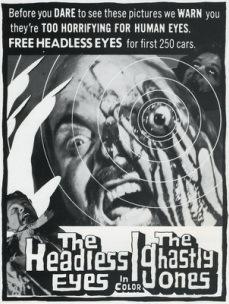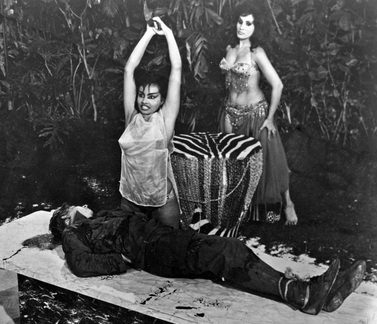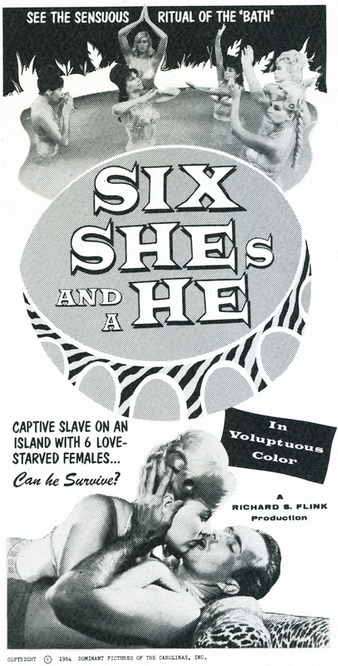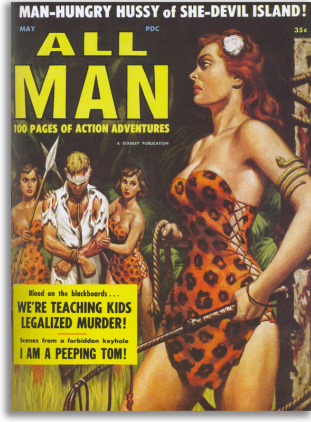Because I was tall for my age and therefore unsuspected by truant officers, junior high and early high school was a good time for skipping class and heading downtown on a public bus to see films that didn't play in either of my two neighborhood theaters. I'd flash my fake I.D. at the box offices of the Loews, The Norva, or the Granby for films such as Macabro (1966) and Succubus (1968). It was a great way to spend a weekday, certainly better than suffering through yet another boring lecture, and I thought I was seeing the most offbeat films in town.

At least that's what I thought until high school, when I took a seat in the cafeteria at a table where each Monday a particular senior would describe to the rest of us what he'd seen at the drive-in the previous weekend. We'd listen raptly as we ate our shitty public school lunches to his tales of sex, gore, and smuggled six-packs amongst the "speaker-stand forest." *
It was soon apparent that the films he was seeing were unique to the drive-in experience, and the realization made me crave my drivers' license. Alas, it would be nearly twenty years before I realized that the "eyeball scooped out with a spoon" cheapie he once recounted scene by scene was Kent Bateman's inimitable The Headless Eyes (1971). Thanks, Wizard Video!
On another day he hushed the table into silence by describing a scene in which a captive soldier was bound to an altar and ritually disemboweled by savage, bikini-clad pagan women. It was about then that some of us began to suspect that Mr. Moviegoer was either greatly enhancing or inventing outright the scenarios he was spinning. But when challenged, the senior indignantly dared those of us at the table to see for ourselves. The film's title: Six Shes and A He (1963).
It was soon apparent that the films he was seeing were unique to the drive-in experience, and the realization made me crave my drivers' license. Alas, it would be nearly twenty years before I realized that the "eyeball scooped out with a spoon" cheapie he once recounted scene by scene was Kent Bateman's inimitable The Headless Eyes (1971). Thanks, Wizard Video!
On another day he hushed the table into silence by describing a scene in which a captive soldier was bound to an altar and ritually disemboweled by savage, bikini-clad pagan women. It was about then that some of us began to suspect that Mr. Moviegoer was either greatly enhancing or inventing outright the scenarios he was spinning. But when challenged, the senior indignantly dared those of us at the table to see for ourselves. The film's title: Six Shes and A He (1963).

His account was later confirmed by my adult cousin, who with his wife had seen Mac Ahlberg's Fanny Hill (1968) at the drive-in along with this unanticipated co-feature. They were both outraged, he because the female cast members remain clothed and she from the ineptitude and overall shoddiness on display.
Over forty years later I finally caught up with this made-in-Florida cheapie, and then only in a truncated video version. However, the infamous scene described by the high-school senior was intact.
London After Midnight (1927) may never turn up, but Six Shes and A He sure did. Somehow, somewhere, Mike Vraney of Something Weird Video located a slightly incomplete print of the film and made it available on DVD-R. Prior to that, Six Shes and A He had largely been overlooked, so much so that when I interviewed its star, the late Bill Rogers, in 1993 for ecco, the world of bizarre video, he neglected to mention it. Or perhaps his omission was intentional.
Over forty years later I finally caught up with this made-in-Florida cheapie, and then only in a truncated video version. However, the infamous scene described by the high-school senior was intact.
London After Midnight (1927) may never turn up, but Six Shes and A He sure did. Somehow, somewhere, Mike Vraney of Something Weird Video located a slightly incomplete print of the film and made it available on DVD-R. Prior to that, Six Shes and A He had largely been overlooked, so much so that when I interviewed its star, the late Bill Rogers, in 1993 for ecco, the world of bizarre video, he neglected to mention it. Or perhaps his omission was intentional.

Rogers portrays "Fred Rogers," a fighter pilot (astronaut, according to the pressbook) who crash-lands in the Pacific Ocean and washes ashore on an island inhabited by six gold-bikini-clad women armed with spears.
Forced to slave in the fields each day and sexually satisfy a different woman every night, the exhausted Rogers soon plots his escape with the aid of a turncoat. The two manage to elude capture, but only after one of the women has been speared through the navel and another has been beaten to death with a sponge.
Originally filmed as Love Goddesses of Blood Island, the jaw-dropping Six Shes and A He was directed by Sting of Death (1965) co-producer, drive-in owner, and building contractor Richard S. Flink (under the pseudonym "Gordon H. Heaver") from a script by Herschell Gordon Lewis regular Bill Kerwin. Keeping it in the family, Kerwin's brother Harry devised the outrageous - especially for 1963 - gore effects. In fact, Six Shes and A He has been credited by some as the first attempted imitation of Godfather of Gore Lewis' landmark Blood Feast from the same year.
As with Lewis' films, the proceedings are so absurd as to instantly strain credulity, and therein lies the appeal. The camp quotient explodes in the scene where Rogers sways ecstatically like Stevie Wonder as he seemingly pretends to play an imaginary keyboard. An unseen vocalist croons the wince-inducing theme "Love Goddess," purportedly written by Al Jacobs, the songwriter behind the patriotic anthem "This Is My Country." (Though the vocals are credited to "Neil Patrick," I suspect that it's actually the pipes of jack-of-all-trades Rogers.) In the background, the Love Goddesses strut and gesticulate like drunk interpretive dancers on a set built around a hideous Romanesque swimming pool. It's the only clip you'll need to set the tone for your next tiki party.
Forced to slave in the fields each day and sexually satisfy a different woman every night, the exhausted Rogers soon plots his escape with the aid of a turncoat. The two manage to elude capture, but only after one of the women has been speared through the navel and another has been beaten to death with a sponge.
Originally filmed as Love Goddesses of Blood Island, the jaw-dropping Six Shes and A He was directed by Sting of Death (1965) co-producer, drive-in owner, and building contractor Richard S. Flink (under the pseudonym "Gordon H. Heaver") from a script by Herschell Gordon Lewis regular Bill Kerwin. Keeping it in the family, Kerwin's brother Harry devised the outrageous - especially for 1963 - gore effects. In fact, Six Shes and A He has been credited by some as the first attempted imitation of Godfather of Gore Lewis' landmark Blood Feast from the same year.
As with Lewis' films, the proceedings are so absurd as to instantly strain credulity, and therein lies the appeal. The camp quotient explodes in the scene where Rogers sways ecstatically like Stevie Wonder as he seemingly pretends to play an imaginary keyboard. An unseen vocalist croons the wince-inducing theme "Love Goddess," purportedly written by Al Jacobs, the songwriter behind the patriotic anthem "This Is My Country." (Though the vocals are credited to "Neil Patrick," I suspect that it's actually the pipes of jack-of-all-trades Rogers.) In the background, the Love Goddesses strut and gesticulate like drunk interpretive dancers on a set built around a hideous Romanesque swimming pool. It's the only clip you'll need to set the tone for your next tiki party.

Even in its current 46 minute runtime, Six Shes and A He is a test of patience. The wooden acting leaves no doubt why the cast's filmographies are scant, with Rogers being the exception. Sets inexplicably switch from an actual beach to godawful astroturf and potted plant imitations of a tropical forest. The flashback scene with the slaughter of the soldier looks as though it's spliced in from another film, with Carol Wintress (as Rebecca) decked out in dragon-lady makeup and grimacing like the voodoo doll that terrorized Karen Black in Trilogy of Terror. And that pathetic decapitation...
So why is such a sow's ear of a film of interest? If you're not of a certain age, it probably isn't. But Six Shes and A He, which was released the same year as Betty Friedan's The Feminine Mystique, is driven by male anxiety about the power of women. Its kitschy tale of female domination dovetails with a recurring theme in so-called "sweat" magazines of the fifties and sixties. These lurid, hyper-masculine fantasies appealed to World War II veterans coping with reintegration to peacetime society and blue collar workers whose masculine identity was in flux in the wake of an expanding female workforce and its demands for equality.
Bill Kerwin's script could have been ripped from the pages of such trashy rags as True Adventures ("The Man-Killing Girls of Lepu"), Sir! ("Duke Moore's 3 Years As A Stud Slave"), and Exotic Adventures ("Island Of Love-Starved Women"). These overblown fantasies take an odd turn, however, in Six Shes and A He, as male hegemony is ultimately undermined: the eventual escape would be doomed to failure but for the heroic actions of a woman, as in Russ Meyer's Faster, Pussycat! Kill! Kill! (1966). All considered, Flink's cheesy costume pageant better reflects the turbulent sexual zeitgeist of 1963 than Tony Richardson's Tom Jones, Joseph L. Mankiewicz's mega-million megabomb Cleopatra, or any other of the year's high-profile films.
But I digress. The senior graduated, shutting down the cafeteria connection, but not before he'd tantalized us with more lunchtime tales of drive-in depravity that will probably remain unidentified. The following year I scored my drivers' license and began my drive-in mongering with the 1971 U.S. release of La residencia (aka The House That Screamed), about a young nutcase building his own perfect woman. It was the beginning of the end for the drive-in era.
So why is such a sow's ear of a film of interest? If you're not of a certain age, it probably isn't. But Six Shes and A He, which was released the same year as Betty Friedan's The Feminine Mystique, is driven by male anxiety about the power of women. Its kitschy tale of female domination dovetails with a recurring theme in so-called "sweat" magazines of the fifties and sixties. These lurid, hyper-masculine fantasies appealed to World War II veterans coping with reintegration to peacetime society and blue collar workers whose masculine identity was in flux in the wake of an expanding female workforce and its demands for equality.
Bill Kerwin's script could have been ripped from the pages of such trashy rags as True Adventures ("The Man-Killing Girls of Lepu"), Sir! ("Duke Moore's 3 Years As A Stud Slave"), and Exotic Adventures ("Island Of Love-Starved Women"). These overblown fantasies take an odd turn, however, in Six Shes and A He, as male hegemony is ultimately undermined: the eventual escape would be doomed to failure but for the heroic actions of a woman, as in Russ Meyer's Faster, Pussycat! Kill! Kill! (1966). All considered, Flink's cheesy costume pageant better reflects the turbulent sexual zeitgeist of 1963 than Tony Richardson's Tom Jones, Joseph L. Mankiewicz's mega-million megabomb Cleopatra, or any other of the year's high-profile films.
But I digress. The senior graduated, shutting down the cafeteria connection, but not before he'd tantalized us with more lunchtime tales of drive-in depravity that will probably remain unidentified. The following year I scored my drivers' license and began my drive-in mongering with the 1971 U.S. release of La residencia (aka The House That Screamed), about a young nutcase building his own perfect woman. It was the beginning of the end for the drive-in era.
* I copped this phrase from the lyrics of "Love in an F.J.," about making out at the drive-in, from the 1972 album "Teenage Heaven" by the Melbourne band Daddy Cool.
This edition includes reviews of Canibal, Child's Pose, and L'inconnu du lac (Stranger By the Lake).
 RSS Feed
RSS Feed